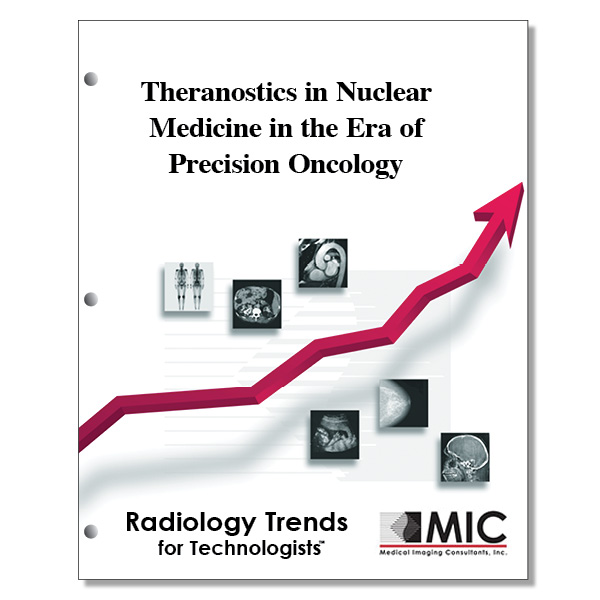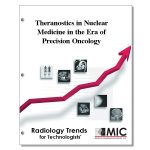

Theranostics in Nuclear Medicine in the Era of Precision Oncology
An overview as well as advanced concepts and future applications are presented of the pairing of diagnostic biomarkers with therapeutic agents that share a specific target in diseased cells.
Course ID: Q00658 Category: Radiology Trends for Technologists Modalities: CT, MRI, Nuclear Medicine, PET, Radiation Therapy3.5 |
Satisfaction Guarantee |
$37.00
- Targeted CE
- Outline
- Objectives
Targeted CE per ARRT’s Discipline, Category, and Subcategory classification:
Nuclear Medicine Technology: 3.50
Procedures: 3.50
Radionuclides and Radiopharmaceuticals: 1.00
Endocrine and Oncology Procedures: 2.50
Outline
- Introduction
- Contextualization of Nuclear Theranostics
- Classic Theranostic Agents
- Radioiodine for Differentiated Thyroid Cancer
- Rationale and Clinical Aspects
- 131I-MIBG for Neural Crest-Derived Tumors
- Rationale and Clinical Aspects
- Neuroblastoma
- Pheochromocytoma and Paraganglioma
- Bone-Seeking Therapeutic Radiopharmaceuticals
- Radioiodine for Differentiated Thyroid Cancer
- From Classic to Modern Theranostic Agents
- Somatostatin Analog Radioligands
- Rationale and Clinical Aspects
- PSMA Radioligands for Prostate Cancer
- Rationale and Clinical Aspects
- Bone-Seeking Agents Revisited
- Hepatic Radioembolization
- Somatostatin Analog Radioligands
- FDG: The Antitheranostic Agent
- Advantages and Limitations of Theranostics
- Advantages
- Limitations
- Perspectives
- Recently Introduced Agents
- Combining Theranostics with Other Diagnostic and Treatment Modalities
- Dosimetry
- Conclusion
Objectives
Upon completion of this course, students will:
- identify the year in which Paul Ehrlich proposed the concept of the “magic bullet”
- identify the year in which the approach of theranostics was first proposed
- describe the criteria that determine the imaging or therapeutic capability of radioisotopes
- describe the types of radiation used for therapeutic nuclear medicine applications
- identify isotopes that emit both electromagnetic and particulate radiation
- list the therapeutic agents used for prostate cancer
- list the diseases that are treated with 90Y-labeled therapeutic agents
- list examples of diagnostic or therapeutic components that comprise hybrid theranostic pairs
- list the diseases that are managed using theranostic pairs associated with chemokine receptor type 4
- identify the year in which radioactive iodine treatment for hyperthyroidism began
- identify the physical half-life of 131I
- identify the most used iodine radioisotope for diagnostic scintigraphy in the United States
- describe the modality of choice for treating differentiated thyroid cancer in the postoperative setting
- list the MIBG radiopharmaceuticals that are limited to use for diagnostic purposes only
- identify the radioisotope that requires thyroid blocking with potassium iodide prior to use
- describe the disease-free survival at 5 years for most patients with stage IV neuroblastoma
- describe the type of radiation associated with the bone-seeking agents rhenium-186 HEDP, rhenium-188 HEDP, samarium-153 EDTMP, and strontium-89 chloride
- list the bone-seeking therapeutic radiopharmaceuticals that are calcium analogs
- identify the year in which the US Food and Drug administration approved the use of OctreoScan as an imaging radiopharmaceutical
- describe the radiation emissions from 111In that led to its use in the first PRRT procedures in 1992
- list the DOTA-chelated peptides that were used in the first study of PRRT with 90Y
- identify the year in which 68Ga-labeled SSTR analogs emerged
- describe the most common noncutaneous cancer in males
- describe the percentage of prostate cancer patients that develop metastatic disease
- identify the cancer type for which 223Ra has been used to treat bone metastases
- list the radioisotopes that have a similar mechanism of uptake as 223Ra
- list the radiopharmaceuticals that are necessary to predict uptake of therapeutic radioisotopes by metastatic lesions
- describe the composition of currently available radioactive microspheres
- list the negative outcomes that are avoided by accurate placement of microspheres in the tumor region
- identify the common molecular feature that is imaged by FDG PET/CT
- list the cancer types for which FDG PET is a component of the theranostic algorithms
- list the imaging system parameters that are limitations associated with the diagnostic portion of theranostic pairs
- list the PET radiotracers for which there are currently no clear and sufficiently studied criteria for response assessment
- describe the assessment standards for treatment response applied to anatomic imaging
- identify the PET radiotracer for which PERCIST 1.1 criteria applies
- describe the unit of measurement for the dose of radiation energy absorbed by a determined tissue
- list the diagnostic PET agents used in clinical trials for neuroendocrine tumors
- identify the clinical trial that compared radiotherapy to best supportive care in patients with prostate cancer
- describe the approximate radiation dose limit to the kidneys in patients without risk factors for renal toxicity
- describe the approximate radiation dose limit to the bone marrow
